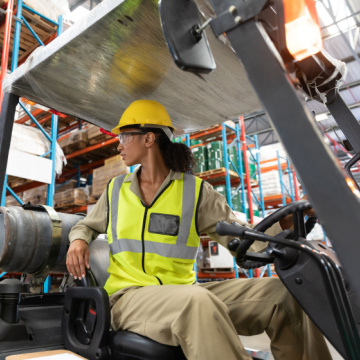Every year, thousands of accidents take place around the world involving vehicles used in workplaces. Unfortunately, many of these mishaps can sometimes lead to loss of life or permanent life changing injuries. People can be run over, knocked down or crushed against trailers, lift trucks, goods vehicles, etc. It has been observed that a significant percentage of accidents occur whilst the vehicle is reversing. There are several accident prevention methods that could be used to safeguard workers from these accidents.
While operating vehicles in a busy warehouse, operators are often focused solely on their job and tend to forget the need to look for people or obstacles behind them. Also, maneuvering these vehicles is not a straightforward process because of vision related limitations faced by the drivers.
Preventive Tips
Luckily, however, the risk of these reversing accidents can be minimised significantly by a few simple precautions.
- Eliminate the need for reversing altogether by setting up one-way systems. For example, drive-through bays can help avoid reversing accidents while loading and unloading.
- Familiarise all the drivers with the workplace layout and ensure that they are well acquainted with the site rules.
- A trained ‘signaller’ can be engaged to guide drivers and ensure that the reversing area is free of pedestrians.
- Increase visibility for drivers by making key adjustments to site layouts. For example, fixed mirrors can be installed in narrow areas.
- Ensure adequate lighting throughout the worksite
- Use reversing aids such as CCTV camera systems
- Provide extensive operator training and supervise them
Reducing the Danger of Blind Spots
A blind spot may be referred to as an area that remains outside the driver’s line of sight while driving. Depending on its type, each vehicle has its own blind spot. In general, larger vehicles have a wider blind spot compared to smaller ones, which poses a great risk of accidents.
Here are a few ways to reduce the probability of accidents caused by blind spots.
- Ensuring that the rear-view and side-mounted mirrors are clean and in good condition.
- Provide greater behind the vehicle visibility to drivers by using reversing camera systems or refractive lenses in the rear window.
- When there is zero visibility behind the vehicles, the drivers should get out of the car and check physically before reversing.
- Use of loud and distinctly audible reversing alarms before reversing.
Improving Workplace Safety Using Advanced Camera Systems
It has been a traditional practice to use rear-view and wing view mirrors in large industrial vehicles to help drivers while reversing. Addition of reversing camera systems allows the drivers to see the obstacles clearly and accurately while reversing. As a result, they can easily navigate a route avoiding walls, boxes, people, and other obstacles.
Many industries dealing with heavy industrial equipment are now keen to invest in rear view camera systems because of their cost and safety benefits. When used in combination with mobile CCTV and cameras with reversing sensors, rear-view camera systems can take the safety to a different level altogether.
If you are looking for the best rear-view camera systems or any other equipment for maximising your workplace safety, ShockWatch is here to help. Our range of accident prevention solutions are suitable for construction, warehousing, mining, shipping, and many other industries.


